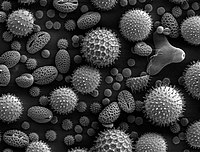
Photo from wikipedia
Van der Waals layered materials, such as transition metal dichalcogenides (TMDs), are an exciting class of materials with weak interlayer bonding, which enables one to create so-called van der Waals… Click to show full abstract
Van der Waals layered materials, such as transition metal dichalcogenides (TMDs), are an exciting class of materials with weak interlayer bonding, which enables one to create so-called van der Waals heterostructures (vdWH). One promising attribute of vdWH is the ability to rotate the layers at arbitrary azimuthal angles relative to one another. Recent work has shown that control of the twist angle between layers can have a dramatic effect on TMD vdWH properties, but the twist angle has been treated solely through the use of rigid-lattice moire patterns. No atomic reconstruction, that is, any rearrangement of atoms within the individual layers, has been reported experimentally to date. Here, we demonstrate that vdWH of MoSe2/WSe2 and MoS2/WS2 at twist angles ≤1° undergo significant atomic level reconstruction leading to discrete commensurate domains divided by narrow domain walls, rather than a smoothly varying rigid-lattice moire pattern as has been assumed in prior experimental work. Using conductive atomic force microscopy (CAFM), we show that TMD vdWH at small twist angles exhibit large domains of constant conductivity. The domains in samples with R-type stacking are triangular, whereas the domains in samples with H-type stacking are hexagonal. Transmission electron microscopy provides additional evidence of atomic reconstruction in MoSe2/WSe2 structures and demonstrates the transition between a rigid-lattice moire pattern for large angles and atomic reconstruction for small angles. We use density functional theory to calculate the band structures of the commensurate reconstructed domains and find that the modulation of the relative electronic band edges is consistent with the CAFM results and photoluminescence spectra. The presence of atomic reconstruction in TMD heterostructures and the observed impact on nanometer-scale electronic properties provide fundamental insight into the behavior of this important class of heterostructures.
Journal Title: ACS Nano
Year Published: 2020
Link to full text (if available)
Share on Social Media: Sign Up to like & get
recommendations!